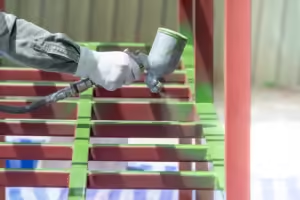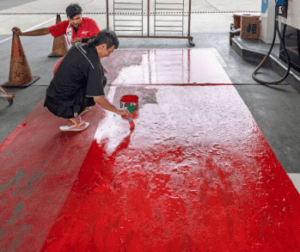Introduction to Specialty Paint Coatings
Specialty paint coatings represent an advanced class of materials distinguished by their ability to provide enhanced functional and protective properties compared to standard paints. These high-performance coatings are engineered to meet the stringent demands of various industries, offering superior resistance to environmental stresses, longevity, and improved aesthetics. By understanding the numerous applications and benefits they offer, professionals in sectors like automotive, aerospace, and construction can harness their full potential for superior results.
Unlike conventional paints, specialty coatings are specifically formulated to withstand unique and often harsh environments. For instance, they may be designed to resist extreme temperatures, chemical corrosion, ultraviolet (UV) radiation, or mechanical abrasion. This makes them essential in industries where durability and performance are critical. Automotive and aerospace sectors frequently rely on these coatings to protect vehicles and aircraft from wear and tear, ensuring safety and extending operational life. Furthermore, they play a vital role in construction, providing robust protection to structures against weather conditions, thereby enhancing durability.
Common types of specialty paint coatings include polymer-based coatings, epoxy coatings, polyurethane coatings, and ceramic coatings. Each type offers distinct properties that make them suitable for specific applications. For example, epoxy coatings are known for their strong adhesion and resistance to chemicals, making them ideal for use in industrial and marine environments. Polyurethane coatings, on the other hand, provide excellent flexibility and abrasion resistance, making them perfect for aerospace and automotive finishes. Ceramic coatings, with their high heat resistance and hardness, are often used in applications requiring thermal protection.
With their wide range of applications, specialty paint coatings are invaluable in ensuring the longevity and functionality of equipment across various fields. Their ability to meet specific performance requirements where standard paints fall short underscores their significance in modern industry practices. It is through a strategic application of these coatings that businesses can maintain optimum performance and extend the life span of their valuable assets.
Types of Specialty Paint Coatings
Specialty paint coatings are essential in various industries, providing protection and enhancing performance under specific conditions. Among the array of specialty coatings available, anti-corrosive, fire-retardant, anti-fouling, and high-temperature resistant paints stand out due to their unique properties and applications.
Anti-Corrosive Coatings: Anti-corrosive coatings are formulated to protect metal surfaces from rust and corrosion. They often contain inhibitors like zinc phosphate or chromates that form a protective barrier against environmental factors such as moisture and salt. Commonly used in maritime, industrial, and automotive sectors, these coatings extend the lifespan of metal components, ensuring durability and reliability. Epoxy, polyurethane, and zinc-rich coatings are typical examples.
Fire-Retardant Coatings: Fire-retardant coatings are designed to slow the spread of flames and reduce the intensity of fire. These coatings expand when exposed to high temperatures, forming a char layer that insulates and protects the underlying material. They are crucial in building and construction, especially for structural steel and wooden components, providing vital time for evacuation and emergency response during a fire. Intumescent paints are a popular choice, meeting rigorous safety standards while maintaining aesthetics.
Anti-Fouling Coatings: Anti-fouling coatings are engineered to prevent the accumulation of marine organisms like barnacles and algae on submerged surfaces, such as ship hulls and offshore structures. By minimizing biofouling, these coatings improve fuel efficiency and reduce maintenance costs. Copper-based and biocide-releasing coatings are widely used, ensuring vessels stay cleaner for longer and contributing to sustainable marine operations.
High-Temperature Resistant Coatings: High-temperature resistant coatings are developed to withstand extreme heat without degrading. These coatings are indispensable in industries like aerospace, automotive, and manufacturing, where components are exposed to high temperatures. Silicone-based and ceramic coatings provide excellent thermal stability and protection against oxidation, ensuring equipment longevity and operational safety.
Understanding the types of specialty paint coatings and their specific applications is crucial for selecting the right product for each unique requirement, thereby optimizing performance and enhancing protection in various demanding environments.


The Science Behind Specialty Paint Coatings
Specialty paint coatings represent a significant advancement in materials science, blending sophisticated chemistry with innovative technology to yield performance-driven solutions. At the core of these coatings is their unique chemical composition, which typically includes a combination of polymers, pigments, solvents, and various additives tailored to meet specific application requirements. The primary role of polymers is to form the film that adheres to the substrate, providing a robust and uniform coating. Pigments add color and can also enhance properties like UV resistance, while solvents dissolve the ingredients to facilitate application.
Additives play a crucial role in the functionality of specialty paint coatings. Commonly included additives are anti-corrosive agents, thixotropic agents, and fungicides, each contributing to the coating’s overall effectiveness. Anti-corrosive agents, for instance, protect metal surfaces from rust, significantly extending the lifespan of infrastructure exposed to harsh environments. Thixotropic agents are responsible for the coating’s optimal viscosity, ensuring smooth application and minimal sagging. Fungicides are essential in preventing microbial growth, a critical feature for maintaining the hygiene and durability of surfaces in damp conditions.
Recent advancements in nanotechnology have revolutionized the field of specialty paint coatings. Nanoscale additives, such as nano-silica, enhance the mechanical durability and scratch resistance of coatings. These tiny particles can also fill micro-voids in the coating, leading to a significantly smoother surface with fewer defects. Furthermore, nanotechnology facilitates the development of self-cleaning coatings, which incorporate hydrophobic or photocatalytic properties to break down and repel dirt and contaminants. This innovation not only reduces maintenance costs but also supports environmental sustainability by minimizing the need for harsh cleaning chemicals.
Innovative techniques, including UV-curable coatings and bio-based solvents, further illustrate the technological advancements in this sector. UV-curable coatings cure and solidify rapidly upon exposure to ultraviolet light, offering a faster application process and reduced downtime. Bio-based solvents provide a more environmentally friendly alternative to traditional solvents, aligning with the growing global emphasis on sustainability.
The interplay between these chemical components and technological innovations underpins the high performance and effectiveness of specialty paint coatings. By understanding this intricate science, one can appreciate the transformative impact these coatings have across various industries, from automotive to aerospace to residential applications.
Applications and Use Cases
Specialty paint coatings play a crucial role across a multitude of industries, each with unique requirements and challenges. In the maritime industry, these coatings are indispensable for protecting ships and underwater structures from harsh saline environments. Anti-corrosive coatings, for example, are extensively used to prevent rust and degradation caused by continuous exposure to seawater, thereby extending the lifespan of marine vessels and minimizing maintenance costs.
In the automotive sector, specialty coatings ensure both aesthetic appeal and functional performance. High-performance coatings protect vehicles from environmental factors such as UV radiation, salt from the roads, and everyday wear and tear. These coatings also offer enhanced durability, providing a long-lasting, glossy finish that retains its look despite frequent exposure to varying weather conditions.
Industrial machinery often faces extreme operational environments, including high temperatures, chemical exposure, and mechanical abrasion. Specialty paint coatings, such as high-temperature resistant and chemical-resistant variants, are critical in safeguarding this equipment. By reducing the risk of corrosion and surface damage, these coatings contribute significantly to the machinery’s operational efficiency and longevity.
The construction industry also benefits from the implementation of specialty coatings. Buildings and infrastructure projects face constant exposure to the elements, necessitating durable protection to preserve structural integrity. For instance, intumescent coatings provide fire-resistant properties, essential for enhancing building safety. Similarly, anti-graffiti coatings help maintain the aesthetic value of public structures by making it easier to clean and remove unwanted markings.
In every application, specialty paint coatings are indispensable for enhancing performance and extending the life of various assets. By mitigating the effects of harsh environments, these coatings play an essential role in reducing maintenance needs, lowering costs, and ensuring the resilience and durability of equipment and structures across diverse industries.
Choosing the Right Specialty Paint Coating
When it comes to selecting the appropriate specialty paint coating for your project, several critical factors need to be evaluated to ensure optimal results. Understanding the environment in which the coating will be applied, the surface material it will cover, and the desired properties of the finished product are crucial in making an informed decision. This section will guide you through these considerations and provide a handy checklist to streamline the selection process.

Understand the Environment
The environment plays a significant role in determining the type of specialty paint coating required. Consider whether the surface will be exposed to high humidity, UV radiation, temperature fluctuations, or harsh chemicals. For instance, epoxy coatings are ideal for industrial applications due to their resistance to chemicals and abrasion, while polyurethane coatings offer superior UV resistance, making them perfect for outdoor environments. Accurately assessing the environmental conditions will narrow down the choices to coatings that can withstand specific challenges.
Assess the Surface Material
Different materials have varying adhesion properties and may interact differently with paint coatings. For example, metal surfaces often require primers to enhance adhesion and prevent corrosion, while wood surfaces need coatings that can expand and contract with temperature variations. Concrete surfaces might require coatings with high durability and resistance to moisture penetration. Identifying the substrate material and any unique requirements it might have is indispensable in choosing the right specialty paint coating.
Desired Properties of the Coating
Every project has its unique requirements, and the desired properties of the coating need to be clearly defined. Whether it’s durability, flexibility, aesthetic appeal, or environmental impact, knowing what you prioritize will help in shortlisting suitable coatings. For example, if a high-gloss finish is desired for aesthetic purposes, a polyurethane coating might be appropriate. Alternatively, if the project demands resistance to biofouling, a marine coating would be more suitable.
Checklist for Selecting the Right Specialty Paint Coating
The following checklist will help streamline your decision-making process:
- Identify the environmental conditions (humidity, UV exposure, temperature, chemicals)
- Determine the substrate material (metal, wood, concrete, plastic)
- List the desired properties (durability, flexibility, finish, environmental impact)
- Review the technical specifications and compatibility of each coating option
- Consult with industry experts or technical representatives if uncertain
- Perform a small test application if possible
- Ensure compliance with local regulations and safety standards
By meticulously evaluating these factors and utilizing the checklist, selecting the right specialty paint coating for your project can be a seamless and efficient process. Proper selection not only enhances the longevity and performance of the coating but also ensures the finished product meets all functional and aesthetic requirements.

Application Techniques and Best Practices
Applying specialty paint coatings requires meticulous attention to detail and adherence to best practices to ensure optimal results. The first step in this process is thorough surface preparation, which is crucial for enhancing the longevity and appearance of the coating. This includes cleaning the surface to remove any dirt, grease, or old paint, and then sanding or etching to promote better adhesion. Proper preparation can mitigate the risk of peeling or bubbling, common issues that compromise the effectiveness of the coating.
The tools and equipment needed for applying specialty paint coatings are specific and, if chosen correctly, can significantly influence the quality of the finish. High-quality brushes and rollers are essential for achieving a smooth and even application, especially on textured or uneven surfaces. For larger areas, airless sprayers can provide a more uniform coat, but they require skill and experience to avoid over-spraying or forming drips. It is also important to use equipment specifically designed for the type of coating being applied—whether it’s water-based, oil-based, or another specialty formula.
When it comes to the actual application, there are several techniques that professionals endorse. A common best practice is to apply the coating in thin, even layers, allowing appropriate drying time between each layer. This technique helps in building a durable finish that resists wear and environmental factors. Additionally, maintaining a wet edge while painting can prevent lap marks and ensure a seamless appearance.
Avoiding common mistakes can further enhance the results. One such mistake is neglecting to stir the paint thoroughly, which can lead to color inconsistency and uneven texture. Another pitfall is applying the coating in unfavorable conditions, such as high humidity or extreme temperatures, which can affect drying time and adhesion. Ensuring proper ventilation during and after application can also prevent issues like streaking or blistering.
Incorporating these application techniques and best practices can unlock the full potential of specialty paint coatings, providing both aesthetic and functional benefits that stand the test of time.
Maintaining and Inspecting Coated Surfaces
Proper maintenance and regular inspection of surfaces treated with specialty paint coatings are pivotal to ensure longevity and optimal performance. Establishing a rigorous maintenance routine not only preserves the aesthetic appeal but also fortifies the protective qualities of the coatings.
The initial step in maintaining coated surfaces involves frequent cleaning to prevent the accumulation of dirt, grime, and other contaminants. A gentle wash using mild detergents and soft brushes or cloths is typically sufficient. It is advisable to avoid abrasive cleaning agents or tools that could potentially damage the coating. For exterior surfaces, periodic washing should align with seasonal changes and environmental exposure levels.
Inspection is equally critical and should focus on identifying early signs of wear and damage. Visual checks should be conducted regularly to spot issues such as discoloration, blistering, peeling, or cracking. These symptoms can indicate that the coating is deteriorating or the surface beneath is compromised. Paying attention to high-traffic areas and sections exposed to harsh weather conditions can preempt more extensive damage.
When signs of wear or damage are detected, prompt action is essential. The repair process usually begins with cleaning the affected area to remove any loose particles or contaminants. Small damages, like minor scratches or chips, can often be rectified with touch-up applications, ensuring the repaired section seamlessly integrates with the existing coating. For more extensive damage, it may be necessary to sand down the area before applying a new layer of specialty paint coating.
Recoating is sometimes unavoidable, particularly in high-wear environments or when the existing layer has significantly degraded. This process generally involves stripping the old paint, adequately preparing the surface, and then applying a fresh coat. Following the manufacturer’s recommendations for re-coating intervals can significantly extend the lifespan of the specialty paint coatings.
Ultimately, consistent maintenance and vigilant inspection are fundamental in maximizing the durability and functionality of specialty paint coatings. By adhering to these practices, surfaces can remain protected and visually appealing for extended periods, yielding long-term cost savings and enhanced performance.
The Future of Specialty Paint Coatings
The specialty paint coatings industry is poised for a transformative future, driven by groundbreaking research and innovative materials. Several emerging trends are shaping the direction of this field, promising not only enhanced functionality but also sustainability and environmental compatibility. Central to this evolution is the development of new materials designed to meet the increasingly complex demands of diverse applications.
One significant area of ongoing research is the creation of nanocoatings. These ultra-thin layers, constructed from nanoscale particles, offer superior protection against corrosion, UV radiation, and microbial growth. The tiny structure of nanocoatings provides a high level of surface energy, improving the adherence and durability of the paint. Such advancements could revolutionize industries ranging from automotive to aerospace, where durability and resistance are paramount.
Future innovations may also involve smart coatings that adapt to their environment. Researchers are exploring materials that can change color, self-heal minor damages, or even convey data about the surface they cover. For example, temperature-sensitive coatings could shift hues to indicate thermal changes, while self-healing coatings could extend the lifespan of a product by automatically repairing scratches and cracks.
Sustainability is another critical factor driving the future of specialty paint coatings. The push towards eco-friendly products has inspired the development of coatings with low volatile organic compound (VOC) emissions. Water-based and plant-based formulations are gaining traction as viable alternatives to traditional solvent-based coatings. Furthermore, the industry is looking into biodegradable coatings that minimize environmental impact while maintaining performance standards.
In addition to material advancements, there is a growing interest in the adoption of digital technologies. Machine learning and artificial intelligence are being leveraged to accelerate research and development processes, optimize formulations, and predict performance outcomes. These technologies can enable more efficient manufacturing practices, reducing waste and energy consumption.
The road ahead for specialty paint coatings is undoubtedly exciting, presenting numerous opportunities for innovation and growth. As research progresses and new materials come to fruition, the potential to redefine the coatings market becomes increasingly tangible, paving the way for more sustainable and high-performance solutions.

